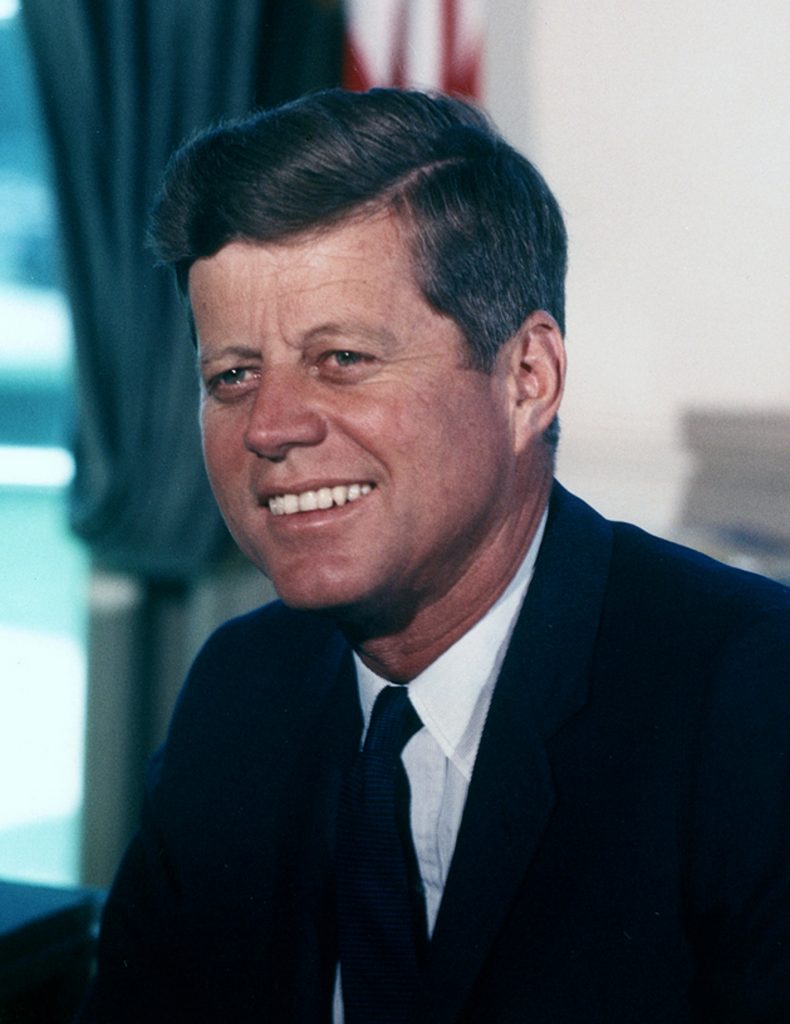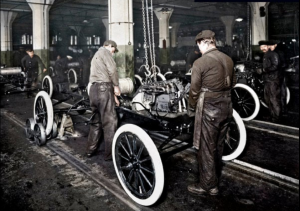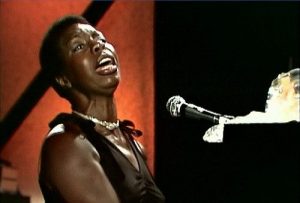Winner of the Fall 2017 StMU History Media Award for
Best Article in the Category of “United States History”
November 22, 1963 was a dark day for America. It was one of those days in the life of a nation when everyone remembers exactly where they were when they heard the news: Kennedy has been shot. New generations of Americans have since been born that did not experience that chilling day. For those who may not know, the people of Dallas were not strong supporters of President John F. Kennedy’s policies, ranging from his support for racial integration and his intention to ban nuclear testing, to rumors of his negotiations with the Soviet Union. Kennedy had hoped to smooth over many of those conflicts and win over many of those who opposed to him in Dallas by going to talk to his critics. His intention for that day in November was to drive through Dallas, give a speech to about 2500 local business leaders, and then ride through the streets of downtown Dallas, seeing thousands of people along the way. He hoped to calm the conflicts between the people who were against him and wanted to create a sense of peace.
Kennedy’s Secret Service Agents had warned Kennedy of the risks of riding through Dallas openly exposed in a “bubble top down” limousine. But Kennedy wanted to wave to his fans and supporters. Disregarding the concern, President Kennedy ordered the car’s top to be removed, and obviously being the president, he got what he wanted.1

By Kennedy’s side sat the beautiful First Lady Jacqueline Kennedy, with Texas Governor John Connally and his wife Nellie riding in the front seats. John F. Kennedy had been in San Antonio as well as Houston the day before riding through and waving to his beloved supporters and fans.2 While in San Antonio with Vice President Lyndon B. Johnson, they visited the United States Air Force School of Aerospace Medicine, as well as attend a testimonial dinner in Houston for United States representative Albert Thomas. The two then flew to Fort Worth to spend the night and rest there. The following morning, Novemeber 22, John F. Kennedy went on to a breakfast sponsored by the Fort Worth Chamber of Commerce, and then flew to Dallas to meet with his lovely wife, and start the ride through Dallas.3
The drive started off with the car making its way through downtown Dallas. The car made a quick left turn onto Elm Street, but to do so, the driver, Secret Service agent William Greer, had to drive at a speed of 11 mph, which was a direct violation of the rules given to ensure the safety of the president. They then rode past the Texas School Book Depository, and then towards a small grassy area called Dealey Plaza.
The large clock seen by many on the top of the billboard atop the Book Depository struck 12:30 pm, and within a matter of seconds sounds of gunshots, screams, and fear echoed through the streets of Dallas. Although it is not clear whether three to six shots were actually fired, it is known for a fact that one pierced through John F. Kennedy’s skull, painting the car red, and Mrs. Kennedy’s hands were suddenly filled with bits and pieces of his actual brain. She went into shock and repeated how she was literally holding her husband’s brains. It was a horrible memory that would last forever in her mind.
The Warren Commission was tasked with investigating the assassination, and it issued its findings less than a year later, concluding that Oswald had perfectly planned out the assassination, and the evidence used to prove it was that he was the only person on duty for the sixth floor at that exact time when JFK was shot, and that three bullets traced directly to his Mannlicher-Carcano meant he had to have fired at JFK.4

What led this man to commit such an act? We have learned that Lee Harvey Oswald’s childhood had been very sad; his mother showed him no love, despite all his efforts to please her, which is rough; every child needs love from their mother. Oswald’s father died leaving him and his siblings to grow up in an orphanage. Being deprived of the affection of parents, he often found himself in trouble. An incident with the Bronx zoo police due to truancy led to the findings that Oswald was of great intelligence paired with hostility and aggression. Oswald joined the US marines at the age of seventeen, and served a short time. He did not take reprimands from his superiors well. From June 1962 to November 1963, Oswald worked for a commercial photography business, a coffee company, and, finally, the Texas School Book Depository in Dallas. There is evidence that in March of 1963 he purchased a rifle and revolver from a mail-order company. Around the same time, April 1963, rumors spread of an attempted assassination on a right-wing extremist, General Edwin Walker. Oswald’s record began when he was arrested twice later that year, in August, for disturbances with anti-Castro Cubans. Oswald took a bus trip to Mexico City, where he visited the Soviet and Cuban embassies in an attempt to obtain a visa to enter Cuba. Being denied entrance into Cuba, Oswald returned to his family in Texas and obtained employment at the Book Depository.5
The evidence found that Oswald must have fled the depository within three minutes after the shooting, then got on a bus, from which he then exited, and then proceeded to enter a taxicab. Soon after the shooting, the Dallas police radioed a description of the suspect to all members of the police force and placed them on alert. Oswald, who had gone to his room and carried his .38-caliber pistol, was approached by police officer J. D. Tippit. Sadly, he shot and killed Tippit and ran to the Texas Theatre, where he was arrested at 2:50 pm.6 Kennedy was rushed to Parkland Memorial Hospital. Despite all the doctors’ efforts, Kennedy was pronounced dead at 1:00 pm, November 22, 1963. Oswald was subsequently murdered before he could even face a court. On November 24, 1963, he was murdered by a night club owner, Jack Ruby.
Jack Ruby was a severely distraught man, who felt a truly deep connection to JFK, which is the primary reason he targeted Lee Harvey Oswald. He was emotionally broken by the so recent and painful loss of the president. Ruby took matters into his own hands. He made a plan, and acted immediately on it. His first stop was an easy stop for him. As he walked through the doors of the Dallas Police Headquarters, police saw nothing more than a friendly-faced man, not knowing his true intentions. He had knowledge of Oswald entering and being held in the facility, which explains why he wanted to wait to see him. Ruby waited, and overheard bad news. He heard that there was a problem with the transportation of some sort, and realized his plan was going to need to be reconstructed. He chose to wait Oswald out. While waiting, things delayed the schedule, and led to Ruby parking one block away, re-entering the building and hiding in the basement garage of the police basement. While waiting out the arrival of Oswald, he noticed the guard on watch at the time had left, and saw an opening to make his way towards the spot Oswald was to arrive at. Making his way, Ruby saw many reporters, and camera lights were going off constantly. And then saw Lee Harvey Oswald. He made his way towards Oswald holding the .38 caliber and then fired at Oswald, killing him on live television. People around the nation witnessed the murder happen within seconds, and then they witnessed the arrest of Jack Ruby that happened immediately after his killing. Ironically, Oswald was rushed to the same hospital where Kennedy had been taken just two days earlier. He was buried the same day Kennedy was laid to rest, November 25, 1963.

John F. Kennedy had a beautiful service. The site was designed by a long known friend, John Carl Wernicke. He was buried in Arlington National Cemetery, and was marked with an eternal flame, symbolizing his lifelong and eternal remembrance. The 22nd day of November, 1963 is a day that will be remembered by many as one of the nation’s saddest days. This was the day the thirty-fifth president, John Fitzgerald Kennedy, was assassinated. This was the day that the nation lost one of its most beloved presidents. This day impacted so many people’s lives because all went through this tragedy together.7
- Stuart A. Kallen, The John F. Kennedy Assassination (Detroit: Lucent Books, 2009), 12. ↵
- Alice L. George, The Assassination of John F Kennedy: Political Trauma And American Memory (New York: Routeledge eBook Collection,2013), 37. ↵
- Handbook of Texas Online, June 2010, “Kennedy Assassination,” Texas State Historical Association. ↵
- James R. Phelan, “The Assassination: assassination,” New York Times, November 23, 1975, 250. ↵
- Salem Press Biographical Encyclopedia, January 2017, s.v. “Lee Harvey Oswald,” by Scott P. Johnson. ↵
- Salem Press Encyclopedia, March 2017, s.v. “President Kennedy is Assassinated,” by Bennet H. Wall. ↵
- Martin Luther King, “John F. Kennedy,”Transition, no. 15 (1964): 27-28. ↵



64 comments
Christopher Hohman
Nice article. November 22nd, 1963 will forever live in infamy. I cannot imagine how Mrs. Kennedy must have felt about her husband’s death. To actually have to hold his brain in her hand must have been terrible. Jack Ruby was so upset that he actually killed Lee Harvey Oswald. He must have really loved president Kennedy. It must have also been a very difficult time for the people of this country to have to witness all of this in just a matter of days. It must have really been something
Raymond Munoz
I’m not very well educated in politics, but my mom has talked about President Kennedy quite a few times. She didn’t talk about him because she was 100% behind him and all of his ideas, no, she would always tell me how fascination came from the scandals of him and his wife. So, that is about as far as my knowledge of President Kennedy goes, and with that I can’t say whether or not the people of Dallas were right or wrong in disliking him so much . Though, with this amazing article I can say that is a truly astonishing, and ironic, how President Kennedy travels to Dallas to calm the people but indirectly creates more chaos. No matter the stances, no human being deserves to be murdered because of another’s personal judgement or hardships.
Angel Torres
The assassination of JFK has always been a tragic and highly controversial topic to many. There are many conspiracy theories behind JFK’s assassination that prompt people to question his death. JFK was a charismatic leader that resonated with a lot of the American people. I always wonder how his presidential term would’ve turned out if he was never assassinated. The article has a very good story board and gives an account on the days leading up to the assassination and after the assassination. I like how the article goes into detail with JFK’s assassination and then into detail on how Oswald was killed.
Jennifer Salas
The assassination of John F. Kennedy is a topic that aways leaves me in shock. I can’t believe this actually happened and that someone got away with doing it in such a public space. Kennedy had such a huge impact even though his presidency was cut short. He’s know for his charismatic character and changing the way people viewed politics. I liked how this article stated a lot of facts and informed the reader about Lee Harvey Oswald life. Oswald has always fascinated me because I wonder if he actually did it and why? I wonder if we will ever get answers and find out exactly what happened that day.
Luis Magana
I am currently woking on writing a descriptive article on John F. Kennedys brother Robert Kennedy. Its interesting how both of them were assassinated. Its fascinating how much of an effect his death had on the US and how brave John Kennedy was and tried to fulfill his duty as president as best as he could. This is a great article it really emphasizes all of Mr. Kennedys work.
Micaela Cruz
I had always found the assassination of JFK and the conspiracy theories tied to the assassination highly interesting. What I liked about this article was how the author specifically focused on the events and details leading up to the tragic moment and then tied it all together with what happened to Oswald. JFK was one of America’s most liked presidents and for him to be brutally shot and killed in front of his wife when he only wanted to unite the country and stop such ugly hatred, it’s unfair that his goal was never completed, and still to this day, the US faces discrimination towards other races. Overall, a great article that was very much attention grabbing.
Daniela Martinez
As someone who calls Dallas home, I am not a stranger to the Kennedy case. I think that what makes this assassination so interesting to everyone in America is the number of discrepancies in the crime scene. Which has made ample room for numerous conspiracy theories, all trying to depict what happened that day in Dallas. What also makes this case so interesting is that it was captured on film, which gives a unique perspective on what happened. This article does a great job of staying away from all the countless theories and simply stating the facts. I liked how this article was able to give more background on Oswald something that most articles don’t do.
Miguel Rivera
The assassination of one of the most prolific Presidents of our nation has intrigued many people and has even had countless conspiracy theories on what exactly happened that day. I find it so interesting that not only was his assassination caught on video, but that Lee Harvey Oswald was also killed on live television. If that were to happen today(not saying that I want it to happen) the effects and the media coverage on a assassination would be completely different to when it happened in 1963, obviously, but the impact that John F. Kennedy had continues to live till this day and hopefully this event in history doesn’t repeat itself.
Gabriela Ochoa
This article started off really well and grabbed my attention. I like how you focused on the other people involved in his murder and how it affect them. I never really knew all the details to JFK’s assassination and that he chose to go to an area where he knew people didn’t like him. I thought that the background that you provided on Oswald and his past really added to the article and made it great.
Christopher King
I really enjoyed reading this article. It was different from many about the shooting because they are mostly focused on the victims involved in the incident. This article does a great job talking about the background of the killers all involved in the Assassination. It is rare for anyone to care about who they are and know them on a more personal level. Much of what is talked about is easily overshadowed by the conspiracies and the event itself but this article stays away from the conspiracy theories and that is what makes this one stand out.